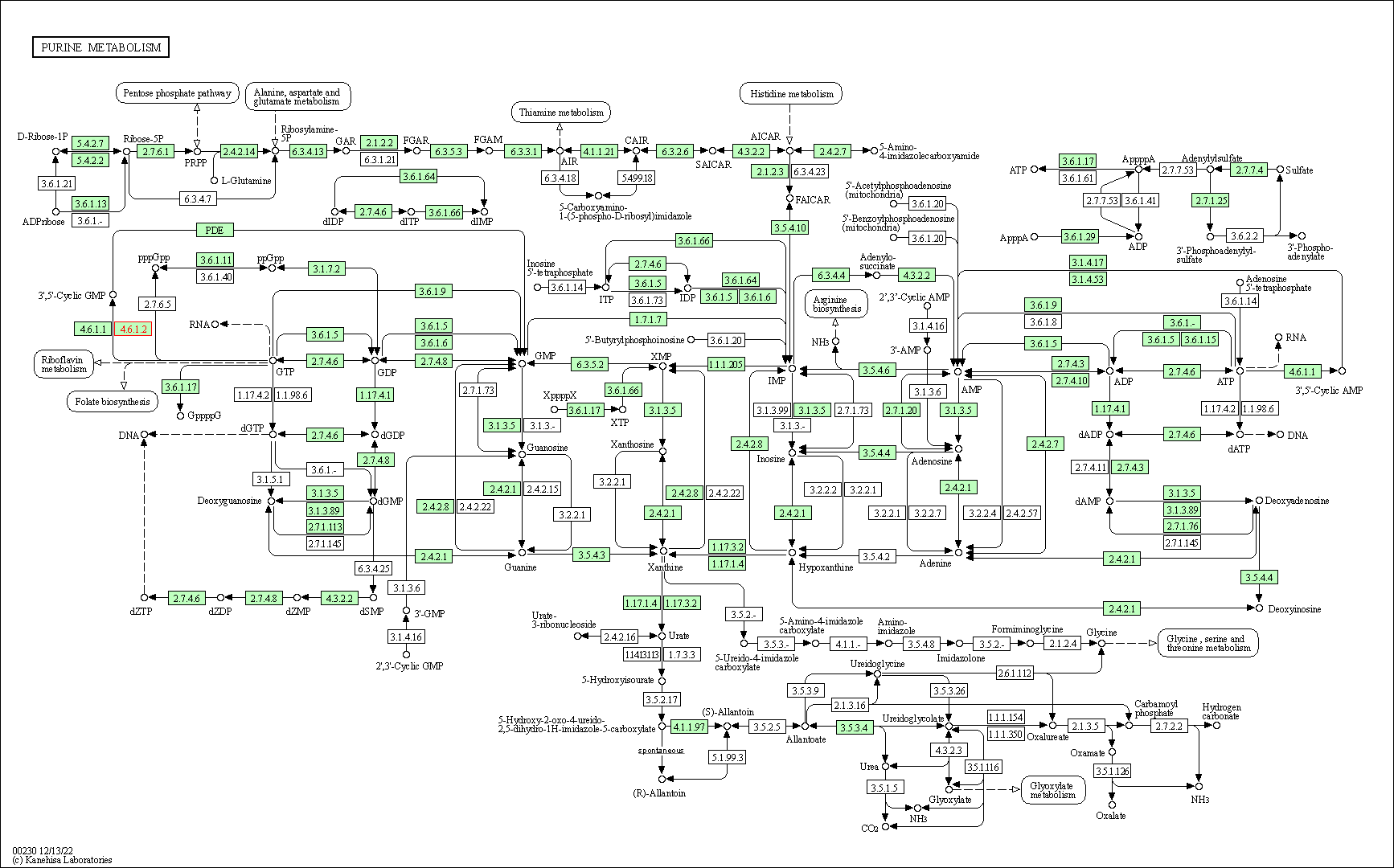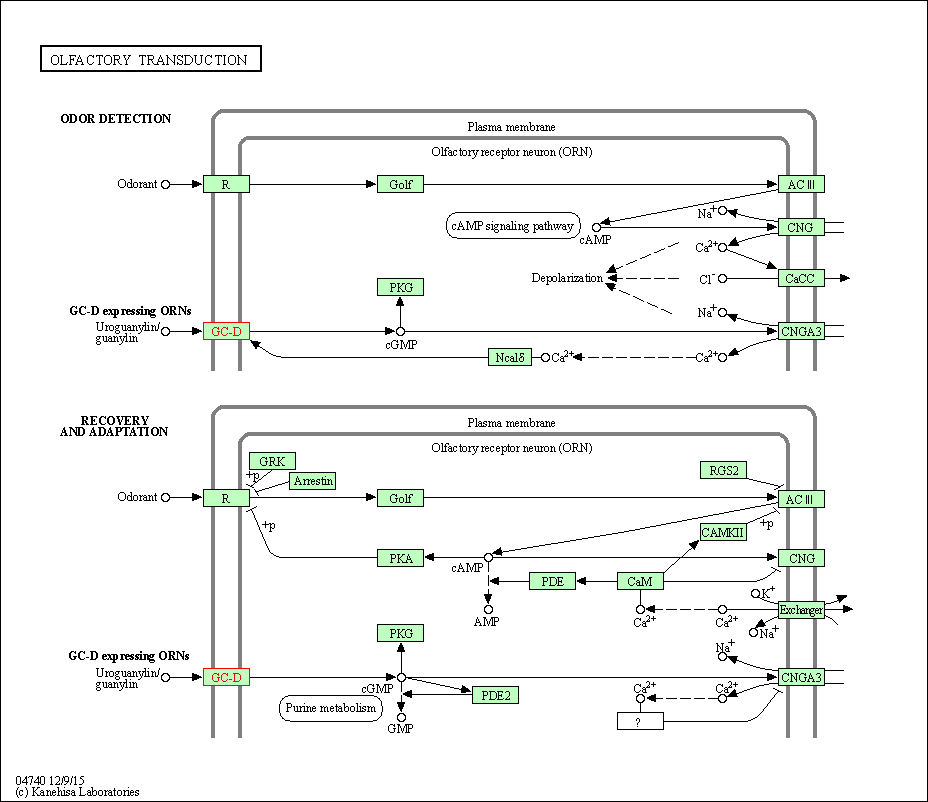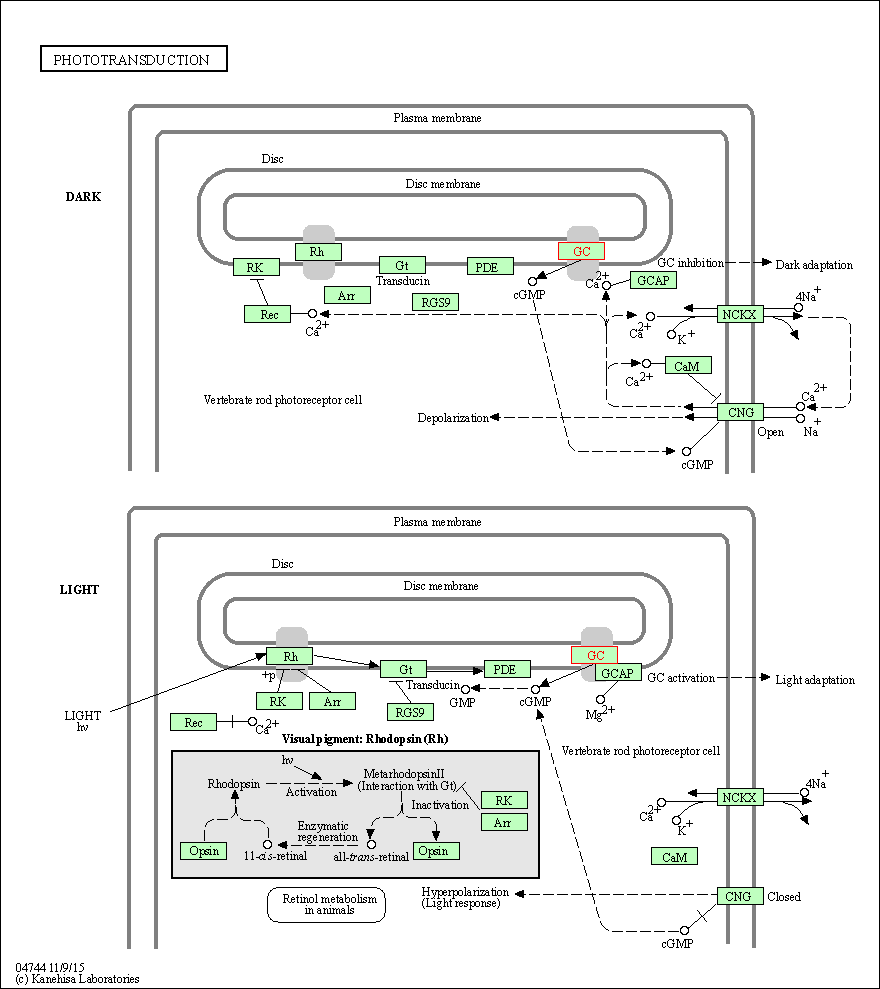Target Information
| Target General Information | Top | |||||
|---|---|---|---|---|---|---|
| Target ID |
T19693
(Former ID: TTDI03001)
|
|||||
| Target Name |
Soluble guanylyl cyclase (GUCY2D)
|
|||||
| Synonyms |
Rod outer segment membrane guanylate cyclase; Retinal guanylyl cyclase 1; ROS-GC; RETGC1; RETGC-1; RETGC; Guanylate cyclase 2D, retinal; GUC2D; GUC1A4; CORD6
Click to Show/Hide
|
|||||
| Gene Name |
GUCY2D
|
|||||
| Target Type |
Successful target
|
[1] | ||||
| Disease | [+] 2 Target-related Diseases | + | ||||
| 1 | Heart failure [ICD-11: BD10-BD1Z] | |||||
| 2 | Pulmonary hypertension [ICD-11: BB01] | |||||
| Function |
Probably plays a specific functional role in the rods and/or cones of photoreceptors. It may be the enzyme involved in the resynthesis of cGMP required for recovery of the dark state after phototransduction.
Click to Show/Hide
|
|||||
| UniProt ID | ||||||
| EC Number |
EC 4.6.1.2
|
|||||
| Sequence |
MTACARRAGGLPDPGLCGPAWWAPSLPRLPRALPRLPLLLLLLLLQPPALSAVFTVGVLG
PWACDPIFSRARPDLAARLAAARLNRDPGLAGGPRFEVALLPEPCRTPGSLGAVSSALAR VSGLVGPVNPAACRPAELLAEEAGIALVPWGCPWTQAEGTTAPAVTPAADALYALLRAFG WARVALVTAPQDLWVEAGRSLSTALRARGLPVASVTSMEPLDLSGAREALRKVRDGPRVT AVIMVMHSVLLGGEEQRYLLEAAEELGLTDGSLVFLPFDTIHYALSPGPEALAALANSSQ LRRAHDAVLTLTRHCPSEGSVLDSLRRAQERRELPSDLNLQQVSPLFGTIYDAVFLLARG VAEARAAAGGRWVSGAAVARHIRDAQVPGFCGDLGGDEEPPFVLLDTDAAGDRLFATYML DPARGSFLSAGTRMHFPRGGSAPGPDPSCWFDPNNICGGGLEPGLVFLGFLLVVGMGLAG AFLAHYVRHRLLHMQMVSGPNKIILTVDDITFLHPHGGTSRKVAQGSRSSLGARSMSDIR SGPSQHLDSPNIGVYEGDRVWLKKFPGDQHIAIRPATKTAFSKLQELRHENVALYLGLFL ARGAEGPAALWEGNLAVVSEHCTRGSLQDLLAQREIKLDWMFKSSLLLDLIKGIRYLHHR GVAHGRLKSRNCIVDGRFVLKITDHGHGRLLEAQKVLPEPPRAEDQLWTAPELLRDPALE RRGTLAGDVFSLAIIMQEVVCRSAPYAMLELTPEEVVQRVRSPPPLCRPLVSMDQAPVEC ILLMKQCWAEQPELRPSMDHTFDLFKNINKGRKTNIIDSMLRMLEQYSSNLEDLIRERTE ELELEKQKTDRLLTQMLPPSVAEALKTGTPVEPEYFEQVTLYFSDIVGFTTISAMSEPIE VVDLLNDLYTLFDAIIGSHDVYKVETIGDAYMVASGLPQRNGQRHAAEIANMSLDILSAV GTFRMRHMPEVPVRIRIGLHSGPCVAGVVGLTMPRYCLFGDTVNTASRMESTGLPYRIHV NLSTVGILRALDSGYQVELRGRTELKGKGAEDTFWLVGRRGFNKPIPKPPDLQPGSSNHG ISLQEIPPERRRKLEKARPGQFS Click to Show/Hide
|
|||||
| 3D Structure | Click to Show 3D Structure of This Target | AlphaFold | ||||
| HIT2.0 ID | T40Q3U | |||||
| Drugs and Modes of Action | Top | |||||
|---|---|---|---|---|---|---|
| Approved Drug(s) | [+] 2 Approved Drugs | + | ||||
| 1 | Riociguat | Drug Info | Approved | Pulmonary arterial hypertension | [1], [2] | |
| 2 | Vericiguat | Drug Info | Approved | Heart failure | [3] | |
| Clinical Trial Drug(s) | [+] 1 Clinical Trial Drugs | + | ||||
| 1 | FK-409 | Drug Info | Phase 2 | Angina pectoris | [4] | |
| Mode of Action | [+] 3 Modes of Action | + | ||||
| Modulator | [+] 3 Modulator drugs | + | ||||
| 1 | Riociguat | Drug Info | [1] | |||
| 2 | Vericiguat | Drug Info | [3] | |||
| 3 | FK-409 | Drug Info | [5], [6] | |||
| Activator | [+] 1 Activator drugs | + | ||||
| 1 | BAY412272 | Drug Info | [7] | |||
| Inhibitor | [+] 2 Inhibitor drugs | + | ||||
| 1 | NS 2028 | Drug Info | [8] | |||
| 2 | ODQ | Drug Info | [9] | |||
| Cell-based Target Expression Variations | Top | |||||
|---|---|---|---|---|---|---|
| Cell-based Target Expression Variations | ||||||
| Different Human System Profiles of Target | Top |
|---|---|
|
Human Similarity Proteins
of target is determined by comparing the sequence similarity of all human proteins with the target based on BLAST. The similarity proteins for a target are defined as the proteins with E-value < 0.005 and outside the protein families of the target.
A target that has fewer human similarity proteins outside its family is commonly regarded to possess a greater capacity to avoid undesired interactions and thus increase the possibility of finding successful drugs
(Brief Bioinform, 21: 649-662, 2020).
Human Pathway Affiliation
of target is determined by the life-essential pathways provided on KEGG database. The target-affiliated pathways were defined based on the following two criteria (a) the pathways of the studied target should be life-essential for both healthy individuals and patients, and (b) the studied target should occupy an upstream position in the pathways and therefore had the ability to regulate biological function.
Targets involved in a fewer pathways have greater likelihood to be successfully developed, while those associated with more human pathways increase the chance of undesirable interferences with other human processes
(Pharmacol Rev, 58: 259-279, 2006).
Biological Network Descriptors
of target is determined based on a human protein-protein interactions (PPI) network consisting of 9,309 proteins and 52,713 PPIs, which were with a high confidence score of ≥ 0.95 collected from STRING database.
The network properties of targets based on protein-protein interactions (PPIs) have been widely adopted for the assessment of target’s druggability. Proteins with high node degree tend to have a high impact on network function through multiple interactions, while proteins with high betweenness centrality are regarded to be central for communication in interaction networks and regulate the flow of signaling information
(Front Pharmacol, 9, 1245, 2018;
Curr Opin Struct Biol. 44:134-142, 2017).
Human Similarity Proteins
Human Pathway Affiliation
Biological Network Descriptors
|
|
| KEGG Pathway | Pathway ID | Affiliated Target | Pathway Map |
|---|---|---|---|
| Purine metabolism | hsa00230 | Affiliated Target |

|
| Class: Metabolism => Nucleotide metabolism | Pathway Hierarchy | ||
| Olfactory transduction | hsa04740 | Affiliated Target |

|
| Class: Organismal Systems => Sensory system | Pathway Hierarchy | ||
| Phototransduction | hsa04744 | Affiliated Target |

|
| Class: Organismal Systems => Sensory system | Pathway Hierarchy | ||
| Degree | 5 | Degree centrality | 5.37E-04 | Betweenness centrality | 4.11E-04 |
|---|---|---|---|---|---|
| Closeness centrality | 1.61E-01 | Radiality | 1.24E+01 | Clustering coefficient | 0.00E+00 |
| Neighborhood connectivity | 3.20E+00 | Topological coefficient | 2.75E-01 | Eccentricity | 14 |
| Download | Click to Download the Full PPI Network of This Target | ||||
| Drug Property Profile of Target | Top | |
|---|---|---|
| (1) Molecular Weight (mw) based Drug Clustering | (2) Octanol/Water Partition Coefficient (xlogp) based Drug Clustering | |
|
|
||
| (3) Hydrogen Bond Donor Count (hbonddonor) based Drug Clustering | (4) Hydrogen Bond Acceptor Count (hbondacc) based Drug Clustering | |
|
|
||
| (5) Rotatable Bond Count (rotbonds) based Drug Clustering | (6) Topological Polar Surface Area (polararea) based Drug Clustering | |
|
|
||
| "RO5" indicates the cutoff set by lipinski's rule of five; "D123AB" colored in GREEN denotes the no violation of any cutoff in lipinski's rule of five; "D123AB" colored in PURPLE refers to the violation of only one cutoff in lipinski's rule of five; "D123AB" colored in BLACK represents the violation of more than one cutoffs in lipinski's rule of five | ||
| References | Top | |||||
|---|---|---|---|---|---|---|
| REF 1 | Radium 223 dichloride for prostate cancer treatment. Drug Des Devel Ther. 2017 Sep 6;11:2643-2651. | |||||
| REF 2 | URL: http://www.guidetopharmacology.org Nucleic Acids Res. 2015 Oct 12. pii: gkv1037. The IUPHAR/BPS Guide to PHARMACOLOGY in 2016: towards curated quantitative interactions between 1300 protein targets and 6000 ligands. (Ligand id: 5257). | |||||
| REF 3 | Drugs@FDA. U.S. Food and Drug Administration. U.S. Department of Health Human Services. 2021 | |||||
| REF 4 | The interaction of FK409, a novel nitric oxide releaser, and peripherally administered morphine during experimental inflammation. Anesth Analg. 1998 Feb;86(2):367-73. | |||||
| REF 5 | Vasorelaxant mechanism of the new vasodilator, FK409. Eur J Pharmacol. 1993 Aug 15;246(3):205-12. | |||||
| REF 6 | Tolerance to the vascular effect of a novel nitric oxide-donating vasodilator, FK409. Eur J Pharmacol. 1994 Aug 1;260(2-3):163-8. | |||||
| REF 7 | NO-independent regulatory site on soluble guanylate cyclase. Nature. 2001 Mar 8;410(6825):212-5. | |||||
| REF 8 | Characterization of NS 2028 as a specific inhibitor of soluble guanylyl cyclase. Br J Pharmacol. 1998 Jan;123(2):299-309. | |||||
| REF 9 | Potent and selective inhibition of nitric oxide-sensitive guanylyl cyclase by 1H-[1,2,4]oxadiazolo[4,3-a]quinoxalin-1-one. Mol Pharmacol. 1995 Aug;48(2):184-8. | |||||
If You Find Any Error in Data or Bug in Web Service, Please Kindly Report It to Dr. Zhou and Dr. Zhang.

